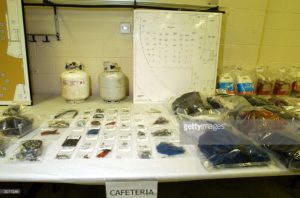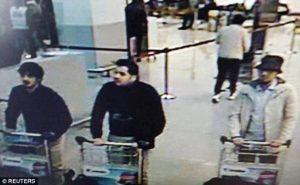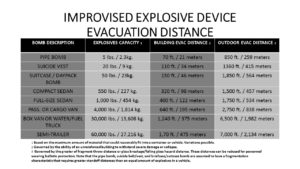Improvised Explosive Device (IED)
 Since first gaining notoriety in 2003 in Iraq, IEDs have been widely used across the world. These devices are easily fabricated with household items and/or chemicals, and they produce massive casualty and injury rates. IEDs are the weapon of choice for many terrorism groups, including Al-Qaeda, ISIL/ISIS, Hezbollah, and Hamas. These devices are a proven tactic and just because we haven’t seen more of these in the United States, doesn’t mean we won’t.
Since first gaining notoriety in 2003 in Iraq, IEDs have been widely used across the world. These devices are easily fabricated with household items and/or chemicals, and they produce massive casualty and injury rates. IEDs are the weapon of choice for many terrorism groups, including Al-Qaeda, ISIL/ISIS, Hezbollah, and Hamas. These devices are a proven tactic and just because we haven’t seen more of these in the United States, doesn’t mean we won’t.
An IED is a seemingly normal container that has been altered to contain an explosive device with a trigger mechanism. Since an IED can literally be made out of anything, one of the keys is noticing the “improvised” part of the container, e.g wires on a thermos bottle. Another key is noticing a normal looking item abandoned in a public location, such as the backpacks during the Boston Marathon. This is why the airports constantly ask travelers to be vigilant about unattended bags but the threat extends past airports.
The optimist in me says that maybe we won’t see an uptick in the IED tactic here; however, the realist in me says be prepared. Not talking about IEDs won’t keep them away, and not training now “because it hasn’t happened yet” is a head-in-the-sand approach. Having a policy which warns the responding agencies to consider staging and be aware of “multiple devices” is great, but we need to move past that to the response phase.

GOLDEN, CO – FEBRUARY 26: Propane tanks, Kerosene, camping fuel, timers and clothing lay on a table containing evidence collected from the cafeteria.. (Photo by Mark Leffingwell/Getty Images)
Response procedures for schools changed in 1999 with the actions of two high schoolers who were poor IED makers but had plenty of ammunition for their guns. Had the two devices Harris and Klebold planted in the cafeteria functioned as designed, we would have different response protocols for IED events today. Due to dumb luck the public did not have to watch Columbine High School burn down with the students and faculty still inside. However, because that didn’t happen we didn’t choose to learn that lesson. Shame on us.
I think the general public and business owners need basic education as they are likely to bear the brunt of any criminal/terrorist attack. Response organizations need to have well exercised response to IED procedures that allow for life-saving actions. Active shooter training is popular right now as it is in the news. Why wait until an IED event occurs to train in a similar fashion?
See Something, Say Something, Do Something
In researching soldiers who were able to detect IEDs in war zones, the military found that familiarity with their environment was key. These soldiers knew when something had changed on their convoy route — if something was missing of if something new had appeared. Some described a “spidey sense,” a feeling of wrongness, something out of place or not quite right with their surroundings. This makes every citizen an important component to keeping their normal places of work, travel and relaxation safe. No police officer or bomb technician is going to know what does and does not belong somewhere more than a person who frequents that location.
 We all have places we frequent and knowledge of what is and isn’t “normal” in certain situations. Learning to listen to our “spidey sense” is important. If you look at the photo of the suspected bombers from the Brussels airport attack, I think many of us would have taken a second look at these gentleman because each were wearing a single glove. It’s odd and out of place, though not illegal. I would not have even mentioned it to security personnel unless I noted other unusual behavior, but I would have kept an eye on them. If you see something odd in your normal travels, notify the authorities and be prepared to take appropriate actions.
We all have places we frequent and knowledge of what is and isn’t “normal” in certain situations. Learning to listen to our “spidey sense” is important. If you look at the photo of the suspected bombers from the Brussels airport attack, I think many of us would have taken a second look at these gentleman because each were wearing a single glove. It’s odd and out of place, though not illegal. I would not have even mentioned it to security personnel unless I noted other unusual behavior, but I would have kept an eye on them. If you see something odd in your normal travels, notify the authorities and be prepared to take appropriate actions.
Estimating Potential Blast Impact by Device Size – Case Study
If you look at the chart below, we could guess the devices detonated in the Brussels airport fit in suitcases. So how far away is safe? The chart suggests 150′ away for a building evacuation with the assumption that you can put something substantial between you and the device. Most airport check-in areas are wide open and safety may lie on the other side of screening. However, you can’t rush through there. Many public buildings in tornado prone areas have identified areas of refuge. If a location is robust enough to withstand a tornado it’s probably substantial enough to brunt the major effects of a non-vehicle borne IED blast.
If we want to follow the outdoor distance (suggested in this case) we’re talking 1,850 feet. That’s over 600 yards or six football fields away. I’m not sure about you, but my sprint time for the 100 yard dash isn’t impressive much less the 600 yard dash. Hollywood movies aside, no one outruns the primary blast wave and propelled shrapnel. Best option in this case would be put distance between you and the device as quickly as possible to get out of the primary blast wave reach and then seek substantial cover (pillars, counter, planter, etc.)
Of course a tactic seen elsewhere has included a combination of IED detonation followed by an attack with grenades and firearms. If you hear a blast, dive for cover, don’t run as you increase the odds of being hit with shrapnel and hitting a vital organ/head. If you chose to move, belly crawl or roll and stay low. If you see a grenade, lay flat on the floor, feet and knees tightly together with soles towards the grenade. Shoes, feet, legs protect the more vital areas of your body.
Shrapnel from a grenade will rise in a cone pattern from the point of detonation, passing over you. Place arms and elbows next to your rib cage to protect heart, lungs and chest. Cover ears/head with hands to protect neck, arteries, ears and skull, and hope that law enforcement is closing on the area to eliminate the threat of remaining shooters. Keep in mind police will not be able to distinguish you from the attackers so laying still until told to get up may be wise.
Train to React
A simple I. E. D. mnemonic which may be of value in these situations.
I: Identify the potential threat and isolate the area to keep others out of harms way
E: Escape the immediate area and evaluate your position for safety using the evacuation distance chart above
D: Decide if the event is ongoing (guns and human threats) or it is safe to render life-saving* aid post-blast
I’m curious to hear if regular training and exercises are taking place within your community or organization for this threat. I hope no reader will need to put this information to use, but forewarned is forearmed.
*Life saving aid includes the ability to rapidly apply a tourniquet, seal a sucking chest wound, and apply a battle dressing. Contact me for planning and training options.




No training that I am aware of in the Chestertown, MD region.
Do you think there is interest in training Barbara?
Telling me my ideas make sense is a very high compliment in my book Barbara, thanks.
Excellent article Jan! I agree 100%. More training and awareness is needed at the business and citizen level.
We recently added sucking chest wound to our CERT Training and I wrote a Field Treatment class and presented the initial training to our Sheriff’s SAR Team. Slightly different focus but, I prioritized the top 5 injuries based on current events. We are all volunteers and could be at ground zero when things go bad, not just in our response roles.
Also, our Sheriff’s and Fire Departments have been working on active shooter and mass casualty response. I hope they have taken IEDs into account.
Hi Jan,
Great article and great information. I agree – we are likely overdue to see more IED incidents domestically. While I’m thankful we haven’t, it’s also led to a measure of complacency and lack of preparedness. Certainly we’ve had some successes in intelligence that have led to the discovery of IEDs prior to detonation, along with a number of incidents avoided when IEDs failed to detonate, but that luck may run out. We need to continue preparedness efforts and continue promoting awareness.
TR
A wonderful first step is the continued effort to have community members become CERT and CART certified. The more wide-spread education, not just among those whose job it is to protect and serve, the better. Awareness is the best long-term gift toward prevention.